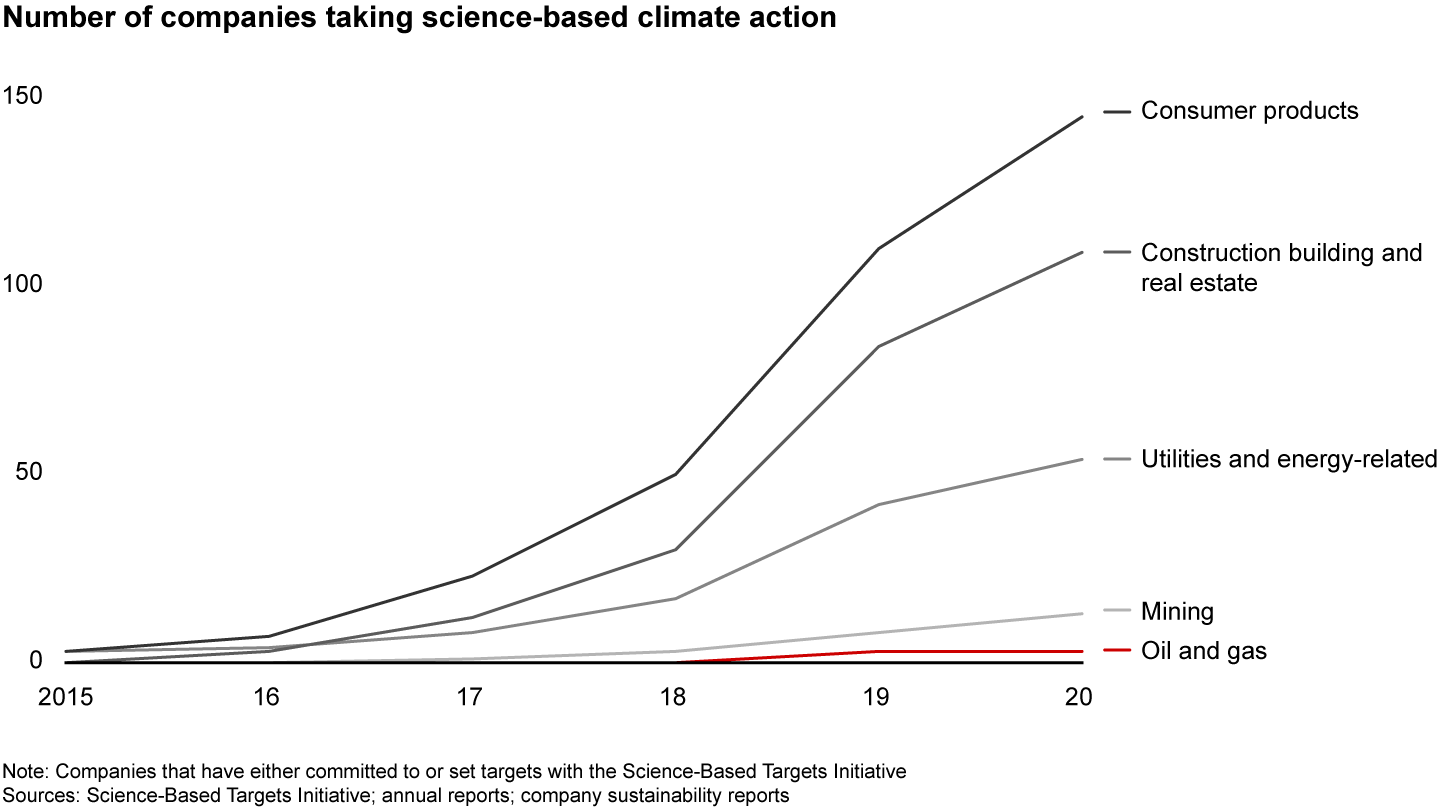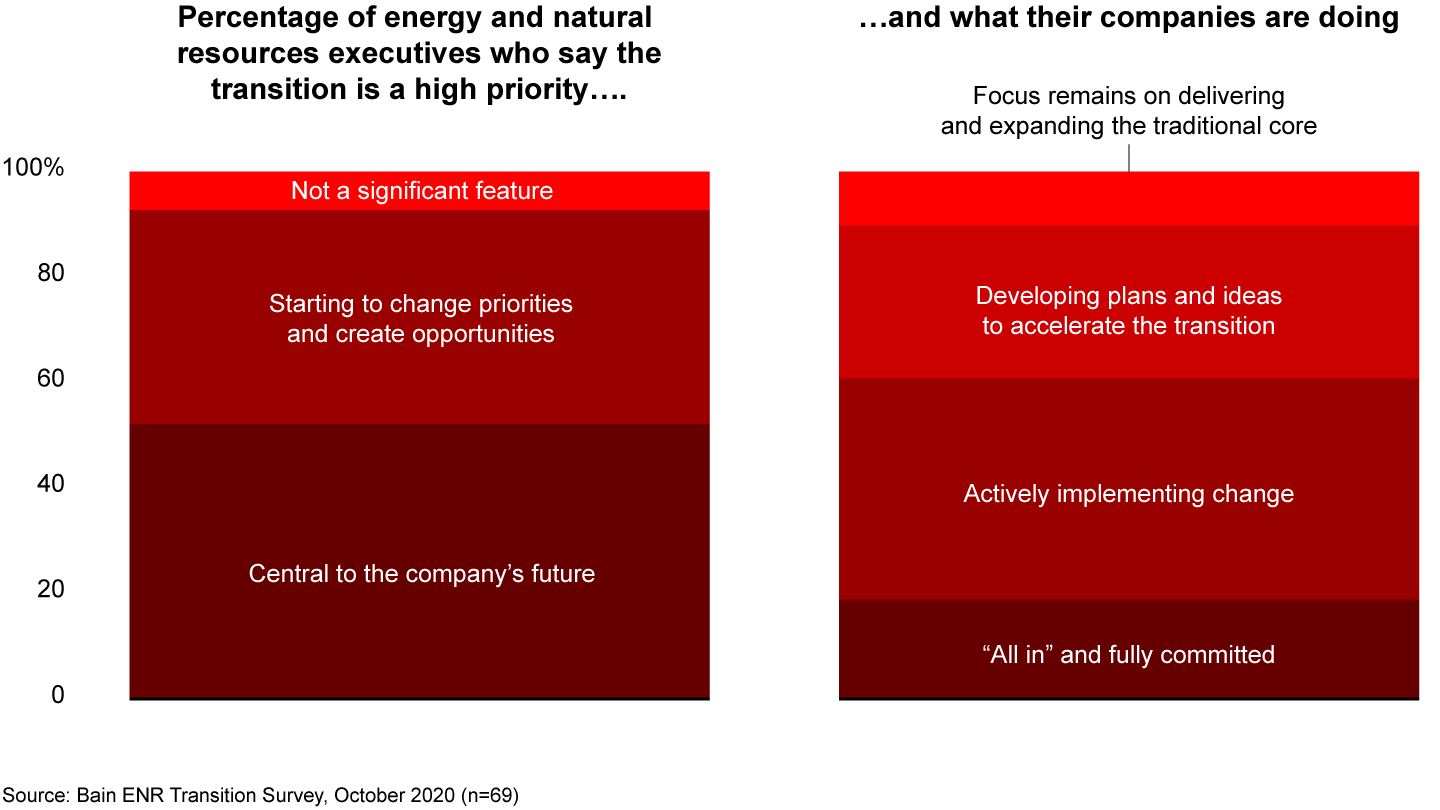Report
 }
}
Executive Summary
- Many companies have set ambitious decarbonization goals in recent months, responding to pressure from activist investors and consumers.
- Delivering on those ambitions won't be easy. Bain research finds that nearly half of all sustainability initiatives fail to reach their goals.
- Leaders set a clear ambition, develop a bankable plan, and embed the goals of carbon reduction in the company. They also recognize they’re part of a broad ecosystem and work with others to achieve common goals.
This article is part of Bain's 2021 Energy and Natural Resources Report.
Climate change was racing up the corporate agenda before Covid-19. Some thought the pandemic would delay action on the climate, given its longer horizon. But in 2021, climate action looks more urgent than ever. Nearly every large company has announced bold decarbonization ambitions, many that include not only the emissions from their own operations, but also those along the supply chain and through the end use of their products.
Boards and management are under pressure from activist investors and highly engaged consumers to pursue those goals. Energy and natural resources companies are also feeling the pressure from insurgents that threaten to take market share with more sustainable products, whether that’s renewable electricity, alternatives to animal protein, or fuels that emit less carbon.
Delivering on these ambitions is proving difficult, particularly for energy and natural resources companies when compared with other industries (see Figure 1). Bain research finds that across industries, sustainability programs have a higher chance of failure (47%) than the 20% failure rate for all change efforts. As with other change programs, companies need to build new capabilities, learn how to measure things in new ways, and hire fresh talent.

Even so, decarbonization stands apart from other change programs, in several ways:
- It takes a long time, often decades instead of years or months.
- People outside the company (such as regulators and investors) can have as much effect on priorities as leaders within a company.
- New technologies and other disruptions can force a shift in strategy, and long-term investment requires a leap of faith in the future.
On the upside, there’s ample opportunity for companies that learn how to move quickly toward their climate goals, primarily because doing so inevitably involves expanding the portfolio to include new lines of low-carbon business (see “When Less Carbon Means More Growth”). New products, new markets, and new ways of working are all part of the path to net zero—changes that can make a company more attractive to investors and customers, who are measuring corporate performance in broader ways.
Half of all energy and natural resources companies have put the energy transition at the center of their strategy, and 41% say they’re shifting priorities to take advantage of new opportunities. About 40% say they’re already implementing changes (see Figure 2).

The companies moving fastest on this path follow similar patterns: leadership aligns on the ambition, develops a bankable plan, and then works to embed decarbonization into the fabric of the organization. At the same time, they learn to see themselves as part of a broader ecosystem, reaching beyond their own organization, working with partners, suppliers, policymakers, and customers to help them in their journey.
Set the ambition
Customers and investors are urging companies to set more ambitious net-zero targets, which aim to reduce a company’s emissions as much as possible and mitigate the remainder by purchasing offsets that remove carbon from the atmosphere. But these targets need to be feasible, with a clear path to success. Most of these goals include not only Scope 1 and 2 emissions (from your own operations and from the energy used to conduct business), but also the Scope 3 emissions that are usually much more extensive, since they include upstream suppliers and the downstream use of products. Although many companies have announced net-zero ambitions 25 or 30 years into the future, it’s important to have a realistic path with verifiable signs of progress toward that goal, if the commitment is to be taken seriously.
Develop a bankable plan
Leaders develop a plan that includes strategic portfolio choices, operational improvements, and investments in offsets, such as forestry projects that preserve or increase natural carbon sinks. For example, many oil and gas companies are rebalancing their portfolios, shedding fossil-fuel assets and investing in renewable energy. Most can also find ways to reduce emissions in their operations. Even so, most won’t be able to reach net zero without purchasing offsets, so they’ll need to find ways to validate offsets and make sure they’re contributing their full measure to the net-zero equation.
Companies prioritize these initiatives by assessing the potential for each and determining which ones are most feasible and fastest to implement. As technologies improve, regulations change, and the price of carbon rises, they’ll have to rebalance the elements of their plan and be willing to change emphasis as opportunities arise.
Embed carbon reduction in the organization
Even the most carefully crafted decarbonization plan won’t deliver results without an organization and operating model designed to move the needle. Embedding the plans in processes, budgets, and metrics can ensure continuing advancement. Decarbonization is likely to be on the agenda for 10 years or more, but it’s not likely to be the top item on the agenda. So companies need to balance decarbonization initiatives with other business priorities, removing obstacles that can thwart success.
Engage with others
To succeed in their net-zero ambitions, companies need to view themselves as part of a broad ecosystem that includes investors, suppliers, customers, competitors, regulators, and other stakeholders, including nongovernmental organizations and local communities. Even more than before, they need constructive conversations with different types of organizations, finding ways to create mutually beneficial solutions. Fortunately, climate change and decarbonization are proving to be topics that bring stakeholders together.
Some of these collaborations may bring together many companies and policymakers, such as Denmark’s climate partnerships, which draw on the expertise of the private and public sectors to develop incentives and regulations for decarbonizing the country’s energy sector (see “Net Zero: From Political Goals to Industry Action”). Other examples will look more like technology development partnerships, like the collaboration between Anglo American mining and Umicore to research and develop technology that could make it easier to use hydrogen in fuel-cell electric vehicles.
These and other examples show that to reach their net-zero goals, companies are raising their climate ambitions and developing strategic roadmaps that include portfolio rebalancing, more energy-efficient operations, and investments in offsets. Some are reorganizing their leadership structure to ensure that accountability for reaching these goals runs from the senior ranks through the entire organization. Finally, recognizing that they can't do it alone, companies are changing the way they work with partners, investors, and policymakers, since they share responsibility to develop constructive solutions that will move everyone closer to net zero.
Read our 2021 Energy and Natural Resources Report
More from the report
-
Two out of Three Won’t Do
-
Harnessing the Energy and Resource Transition
-
Net Zero: From Political Targets to Industry Action
-
Energy Is Only One Part of the Sustainability Transition
-
Redesigning Value Chains to Deliver More Sustainable Goods
-
Time for ESG Investors and Energy and Natural Resources Companies to Work Together
-
Business Opportunities in Low-Carbon Hydrogen
-
Raising Productivity in Energy and Natural Resources Capital Projects
-
Creating Resilience, Sustainability, and Accountability in Supply Chains
-
Engine 2: How to Grow a Sustainable New Business
-
Accelerating the Journey to Net Zero
-
Four Ways to Scale Digital in Energy and Natural Resources Companies

